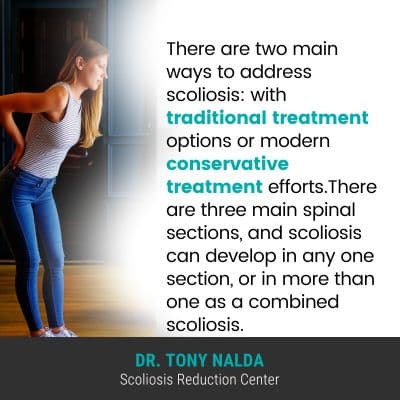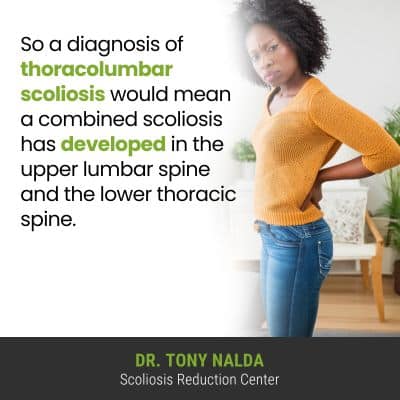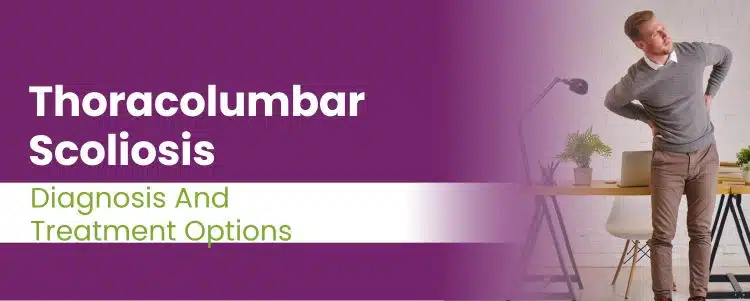Different curvature locations and patterns are associated with different effects. In most spinal conditions, the area of the body located the closest to an affected spinal section is going to feel the majority of its direct effects.
Not only are there different types and severity levels of scoliosis, but there are also different curvature types and locations. Thoracolumbar scoliosis is a combined scoliosis that develops in the upper lumbar spine and the lower thoracic spine.
When scoliosis is diagnosed, conditions are comprehensively assessed so they can be classified accordingly, and curvature location is an important classification-point.
Diagnosing Scoliosis
To diagnose scoliosis, certain parameters have to be met, including the development of an unnatural sideways-bending and twisting spinal curve; it’s the rotational component that makes scoliosis a 3-dimensional condition.
In addition, the size of the curve has to be a minimum of 10 degrees, and this is determined by a measurement known as Cobb angle.
A patient’s Cobb angle is a measurement taken during X-ray; lines are drawn from the tops and bottoms of the curve’s most-tilted vertebrae, at its apex, and the resulting angle is expressed in degrees.
The higher a patient’s Cobb angle, the more severe the condition, and condition severity is a key piece of condition information that treatment plans are shaped around:
- Mild scoliosis involves Cobb angle measurements of between 10 and 25 degrees
- Moderate scoliosis involves Cobb angle measurements of between 25 and 40 degrees
- Severe scoliosis has a Cobb angle of 40+ degrees, and very-severe scoliosis is diagnosed at 80+ degrees
Condition severity is a key characteristic that treatment plans are shaped around, and in addition to severity, patient age, and condition type, there is also curvature location; these classification points help streamline the treatment process, inform the customization of treatment plans, and indicate the types of symptoms of scoliosis a patient can expect.
Patient Age

Patient age is important because as a progressive condition, the nature of scoliosis is to get worse over time, and growth is what triggers progression; in childhood scoliosis, we know that a large focus of treatment is going to be counteracting the constant trigger of growth.
In addition, we also know that scoliosis doesn’t become a compressive condition until skeletal maturity has been reached, so for children, scoliosis isn’t overly painful, but in adults, pain is the number-one symptom that brings them in for a diagnosis and treatment.
A growing spine is experiencing a constant lengthening motion that counteracts the compressive force of the unnatural spinal curve, and it’s compression of the spine and its surrounding muscles and nerves that causes the majority of condition-related pain.
So patient age is important because it indicates potential progression and whether or not pain management will need to be a focus of treatment.
Condition Type
Condition type is important because it indicates a condition’s causation.
The most common type of scoliosis to affect all ages is idiopathic scoliosis, and the most prevalent type of scoliosis overall is adolescent idiopathic scoliosis, diagnosed between the ages of 10 and 18.
Idiopathic means cause unknown, and approximately 80 percent of known diagnosed cases are idiopathic scoliosis, and the remaining 20 percent are associated with known causes: neuromuscular scoliosis, congenital scoliosis, and degenerative scoliosis.
Neuromuscular disorders cause the development of neuromuscular scoliosis as a related complication; congenital scoliosis is caused by a malformed spine that develops in utero so babies are born with the condition, and degenerative scoliosis affects older adults and is caused by natural age-related spinal degeneration
A condition’s cause, when known, has to be addressed with treatment as the underlying cause of the condition.
Curvature Location
In addition to different severity levels and types of scoliosis, there are also different curvature types, patterns, and locations.
Different curvature types and locations can be associated with different rates of progression and scoliosis symptoms.
In most spinal conditions, it’s the area surrounding an affected spinal section that feels the condition’s direct effects, so where along the spine the scoliosis has developed is important.
The spine has three main spinal sections, and scoliosis can develop in any section, or in more than one as a combined scoliosis: cervical spine (neck), thoracic spine (middle/upper back), and the lumbar spine (lower back).
Each spinal section has unique roles to play in maintaining spinal health and function, and each spinal section has a characteristic curvature type, such as lordosis or kyphosis.
Lordotic curves bend forward, while kyphotic curves bend backward.
The cervical spine has to support the weight of the neck, the head, and facilitate the neck’s ability to move the head.
The thoracic spine is the largest spinal section so is vulnerable to the development of a number of spinal conditions/issues, and the thoracic spine is the only spinal section that attaches to the rib cage.
The lumbar spine has to support the weight of the spinal sections above, the entire trunk, and its vertebrae feel the effects of bending, lifting, and twisting motions.
What is Thoracolumbar Scoliosis?

So a diagnosis of thoracolumbar scoliosis would mean a combined scoliosis has developed in the upper lumbar spine and the lower thoracic spine.
Direction of the curve is important too; in typical cases of idiopathic scoliosis, curves bend to the right, away from the heart, and this is known as dextroscoliosis, but in atypical types with known causes, curves can bend to the left, towards the heart, known as levoscoliosis.
So in most cases of thoracic scoliosis, curves will bend to the right, and when they bend to the left, this is associated with congenital and neuromuscular scoliosis.
There are two main ways to address scoliosis: with traditional treatment options or modern conservative treatment efforts.
Thoracolumbar Scoliosis Treatment Options
Traditional scoliosis treatment offers a reactive surgical response, while conservative treatment offers a proactive nonsurgical response.
Here at the Scoliosis Reduction Center®, patients benefit from a conservative treatment approach that works towards preventing progression, increasing condition severity and effects, and the need for invasive surgical treatment in the future.
As a progressive condition, scoliosis treatment isn’t about curing scoliosis, it’s more about how best to manage a life-long condition for the best possible quality of life; scoliosis can be highly treatable.
There are a number of professional athletes and celebrities that went on to fulfill their life-long dreams and goals, despite being diagnosed with a progressive spinal condition, and while there are never treatment guarantees, with early diagnosis and early intervention, there are fewer limits to what can be achieved.
Traditional treatment offers spinal fusion if/when conditions progress into the severe classification, but does little to prevent that type of progression beforehand, while conservative treatment is started as close to the time of diagnosis as possible because this is when conditions are going to be at their mildest and most responsive to treatment.
As scoliosis progresses, the spine gets increasingly rigid, making it less responsive to treatment and making it difficult for some patients to perform key therapeutic exercises as part of treatment, hence the benefit of starting treatment early.
Conservative treatment is integrative so combines multiple scoliosis-specific treatments such as chiropractic care, physical therapy, scoliosis-specific exercises, corrective bracing, and rehabilitation to impact conditions on every level.
Conclusion
When it comes to diagnosing scoliosis, this is achieved through a combined physical examination that includes taking the patient’s family history and medical history, observing their posture, gait, and conducting an Adam’s forward bend test.
If a physical examination finds condition indicators, an X-ray is ordered to see what’s happening in and around the spine: to confirm the unnatural lateral spinal curve, the rotational component, and determine the patient’s Cobb angle measurement.
If a diagnosis of thoracolumbar scoliosis is reached, an unnatural sideways bend and twist has developed in the upper lumbar spine and the lower thoracic spine, and this is a common curvature type and location.
When scoliosis develops in the thoracic spine, a common effect is the development of a rib cage arch because the thoracic spine is attached to the rib cage, and when scoliosis affects the lumbar spine, a common effect is sciatic nerve pain; this is because the sciatic nerve starts in the lower back so can be exposed to compression.
Regardless of patient age, condition severity, type, or curvature location, as a progressive condition, the best time to start scoliosis treatment is always now, and here at the Center, my patients benefit from a proactive conservative treatment approach that works to preserve as much of the spine’s natural strength and function as possible, throughout treatment and beyond.




